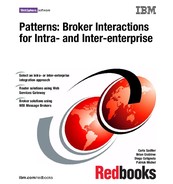Chapter 7. Technology options 135
model, for security, and for the coupling strength between requestor and
provider. The simplest effect is that parameters in Web services are
in-parameters and never in-out-parameters. To return a response value you have
to use the return value of the method.
The security impact results from the fact that in the case of CORBA or RMI the
client is remotely acting in the address space of the server application.
Reference errors can lead to server-side memory access exceptions or data
corruption, for example.
Furthermore, in the case of CORBA and RMI the structures of the stub objects
are identical to those on the server side. Changing the object structure on the
server side needs a refactoring of the clients. In the case of SOAP, no object
structures are exposed, except for methods which can have objects as
parameters and return values. Changing the object structure on the server side
need not lead to a refactoring of the client as a direct consequence.
7.4 J2EE Connector Architecture
The J2EE Connector Architecture is aimed at providing a standard way to access
enterprise applications from a J2EE-based Java application. It defines a set of
Java interfaces through which application developers can access heterogeneous
EIS systems, for example, legacy systems such as CICS, and Enterprise
Resource Planning (ERP) applications.
J2EE Connector Architecture 1.0 support is a requirement of the J2EE 1.3
specification. It provides access to a range of systems through a common client
interface API (CCI). Application programmers code to the single API rather than
having unique interfaces for each proprietary system. The link from the API to the
enterprise system is called a resource adapter and is provided by a third-party
vendor. This is somewhat analogous to the model for JDBC drivers. Resource
adapters are packaged as resource adapter archive (RAR) files.
IBM WebSphere Application Server V5.0 supports the J2EE Connector
Architecture 1.0, as required by the J2EE 1.3 specification. The administrative
console supports J2EE Connector resource adapter configuration. The
administrative console allows the association of connection factories for the
resource adapter that encapsulate the pooling attributes.
Component providers request a connection for an enterprise information system
(EIS) from the connection factory through the JNDI lookup mechanism. IBM
supplies resource adapters for enterprise systems such as CICS, HOD, IMS,
SAP, and Crossworlds as separate products.
136 Broker Interactions for Intra- and Inter-enterprise
IBM WebSphere Studio Application Developer V5.0 supports application
development using J2EE Connectors, and development of custom J2EE
Connectors.
7.4.1 CICS resource adapter
The CICS Transaction Gateway (CICS TG) V5 is a set of client and server
software components that allow a Java application to invoke services in a CICS
region.
The CICS TG offers three basic interfaces for Java clients:
? External Call Interface (ECI) for COMMAREA-based CICS applications
? External Presentation Interface (EPI) for 3270-based transactions
? External Security Interface (ESI) for password management to verify and
change user IDs and passwords
The CICS resource adapter is covered in detail in the following chapters.
7.4.2 IMS resource adapter
The IMS Connector for Java provides a way to create Java applications that can
access IMS transactions. The IMS Connector for Java uses IMS Connect to
access IMS. IMS Connect is a facility that runs on the host IMS machine and
supports TCP/IP and Local Option communication to IMS. A Java application or
servlet accesses IMS Open Transaction Manager Access (OTMA) through IMS
Connect. IMS Connect accepts messages from its TCP/IP clients and routes
them to IMS OTMA using the Cross-System Coupling Facility (XCF).
The runtime component of IMS Connector for Java is provided as a component
of IMS Connect, Version 1 Release 2 (Program Number 5655-E51). The J2EE
Connector implementation of this runtime component is also referred to as the
IBM WebSphere Adapter for IMS. It is packaged as a RAR file, imsico.rar, for
deployment into a WebSphere Application Server. The RAR file is installed to a
target directory from the IBM IMS Connect, Version 1 Release 2.
7.4.3 Advantages of J2EE Connectors
Some reasons to use J2EE Connectors are:
? The common client interface simplifies application integration with diverse
EISs. This common interface makes it easy to plug third-party or home-grown
resource adapters into your applications.
Chapter 7. Technology options 137
? Each EIS requires just one implementation of the resource adapter since
there is no need to custom develop an adapter for every application.
? J2EE Connectors facilitate scalability and provide Quality of Service features
transparently to the client application.
? J2EE Connector Architecture-compliant resource adapters are portable
across J2EE application servers. If a vendor provides a resource adapter for
WebLogic, for example, it should also work with the WebSphere Application
Server.
? J2EE Connectors have low intrusion on the enterprise system because native
client interfaces are utilized.
7.4.4 Disadvantages of J2EE Connectors
Some J2EE Connector issues to consider are:
? J2EE Connector Architecture has support only for synchronous
communication. (The CICS adapter does offer support for non-blocking calls.)
Support for asynchronous communications is expected in the J2EE
Connector Architecture 1.5 specification.
? The J2EE Connectors standard is still relatively new, and performance
compared with previous alternatives has not been firmly established. For
example, some customers may prefer to continue with the well-proven
non-J2EE Connector CICS TG base classes.
? Though J2EE Connector Architecture promises an abstraction to access any
legacy system, with J2EE Connector Architecture 1.0, parts of the client
application need to have resource adapter-specific implementation. This
means that if you have to change the resource adapter (move to a different
enterprise system, which provides a different adapter), the client application
will be affected.
For more information on J2EE Connectors and CICS, refer to the following
redbooks:
? Java Connectors for CICS: Featuring the J2EE Connector Architecture,
SG24-6401
? Revealed! Architecting Web Access to CICS, SG24-5466
..................Content has been hidden....................
You can't read the all page of ebook, please click here login for view all page.
